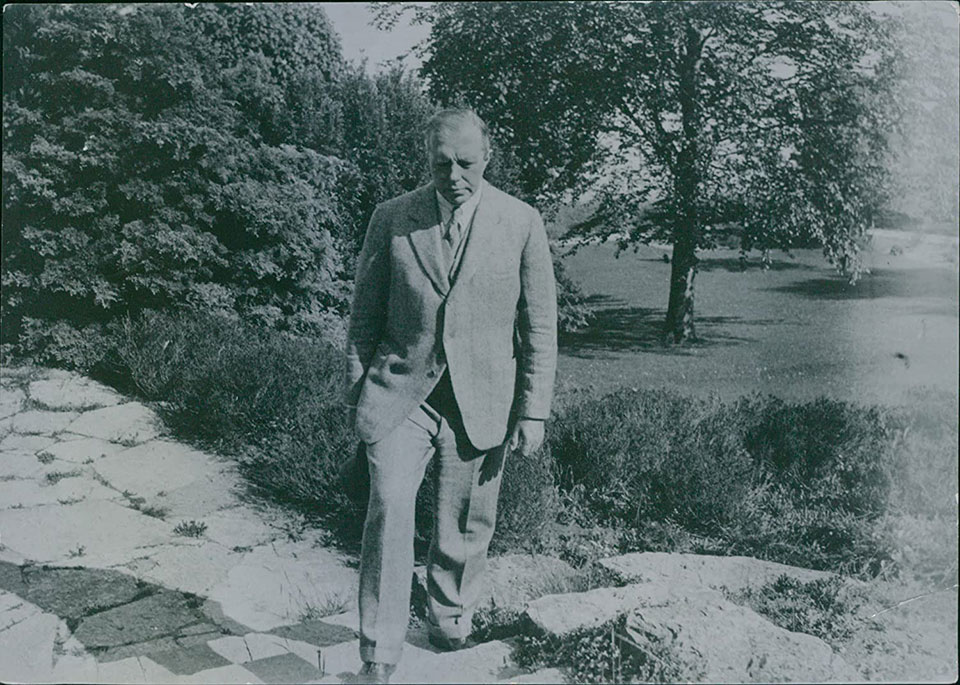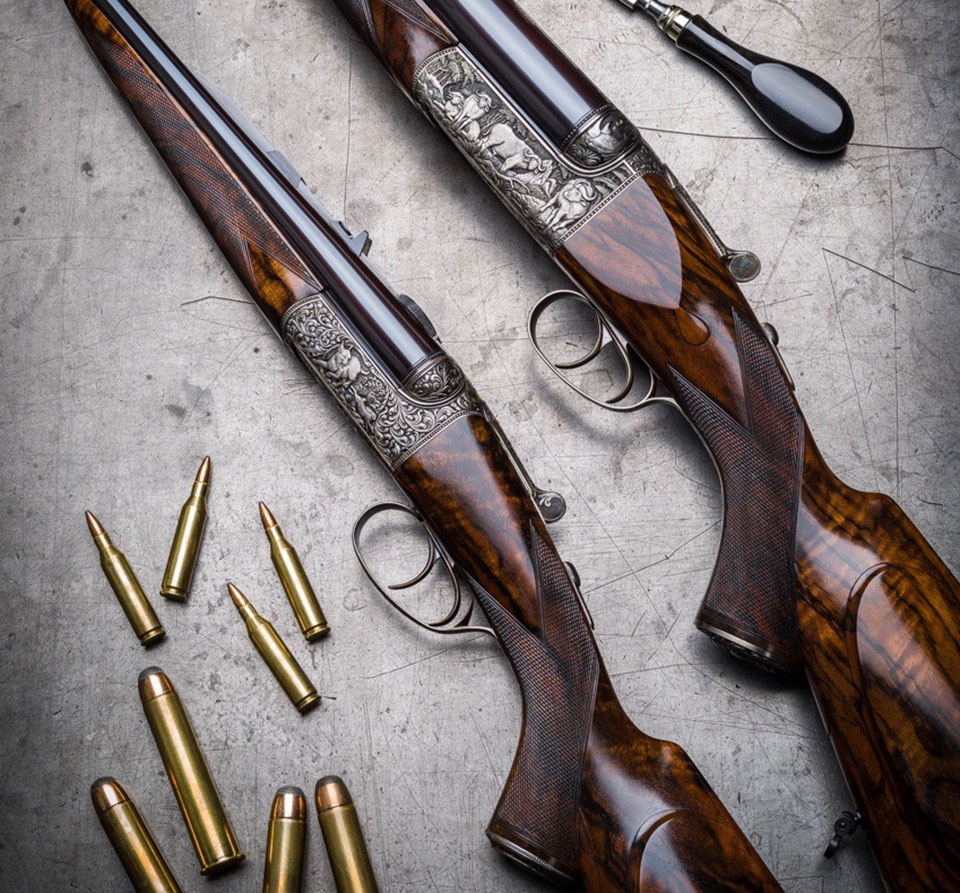A well-known gun writer and commentator told me years ago that the world of guns was awash with male ego and testosterone. Part of it linked to the fact that the gun is a projection of power. You literally transfer that power from your shoulder to your target in order to vanquish it. That swagger and pride some men display about how well they handle their weapon may well be very Freudian. Perhaps this is most obviously displayed by the somewhat macho desire for huge calibre double rifles.
Before the advent of nitro powders in the latter years of the nineteenth century, big game was tackled with ‘bore rifles’. Essentially these were large bore rifles firing huge bullets with as big a charge of black powder as the hunter could physically tolerate. Some old timers wrote of nose bleeds, loose teeth and headaches resulting from their exploits in Africa with these shoulder-canons. They were tackling beasts that were still physiologically mysterious to most adventurers and the simple solution they settled upon was to hit the big animal as hard as they could with the biggest lump of lead they could get airborne.
The safari battery composer would replace the bore rifle with the nitro express.
Black powder is a good deal less potent than the nitro-cellulose based replacements that began to gain popularity as Victoria’s century drew to a close. The twentieth century would be the era of smokeless powders and the safari battery composer would replace the bore rifle with the nitro express; a smaller calibre rifle pushing specially designed bullets much faster than had been possible before.
The calibres that had, up to that point, been designed for deer and medium game became elephant stoppers. Instead of lobbing a 1/4lb ball from a 4-bore, hunters were able to place an accurate shot using a 500 grain bullet travelling fast enough to penetrate deep and inflict sufficient damage and shock to kill even the biggest, toughest animals. Hunters were also learning more about anatomy and the importance of shot placement in order to kill quickly and effectively. The .450 NE was commonly established as an ideal big-game killer and was used all over the world. If the .450 were the only big-game calibre available in the last hundred years, I doubt sportsmen would have suffered too much.
However, it is in the nature of gun making to constantly seek the new and the better, however incremental. It is also in the nature of hunters to seek-out the new and better, however incremental. It is a convenient meeting of minds, which is also good for business.
The .450NE is a capable dangerous game rifle and it was popular everywhere. However, for some hunters the idea always nags away; ‘bigger must be better’. If the .450NE is good, so the logic goes, then surely a .577NE must be better and a .600NE better still. It might just stop a charge a bit sooner or drop an animal a bit faster. One can’t help thinking that they expect a really big bullet to kill it ‘deader’. At least, it provides confidence in a slightly greater margin for error.

Those are the practical explanations but I think there might just be one or two less obvious ones. ‘Mine’s bigger than yours’ is a classic male competition and pulling out a bigger rifle than your Professional Hunter carries, shows that you mean business. We must also recognise that in the last seventy years many of the rifles built by our top gunmakers are not primarily tools of their owners’ trades, like they were when John Taylor was writing about his elephant hunting adventures in the 1950s.
Most of these, hugely expensive, works of art are for collectors to store in their gun vaults, to occasionally lift off the shelf, put in the hands of friends or visitors and say ‘look at that!’ with a sense of pride and achievement.
Once you have handled most of the commonly useful calibres of rifle, the next obvious step to take in order to impress the uneasily impressed is to put something huge in his hands. Something bigger than the last one. This perhaps, provides the impetus for many of the orders for super quality bespoke double rifles of huge calibre that exist today.
A case in point is the .600NE. I have hunted in Africa with a .577NE and it is a superb hunting rifle. Everything I shot and saw shot with it hit the ground and didn’t move. But that was also true of my experiences in Botswana seeing a .470NE in action. Same results. Paul Roberts knows more about African hunting than any Englishman I can think of and he thinks a .470NE is all anyone needs. Yet, the .600 is there. People have ordered before them and still order them.
It is a centre-fire cartridge with a three inch, slightly tapered, brass case, capable of firing a 900 grain bullet at 2,050 fps.
So, practically, what is a .600 Nitro Express? It is a centre-fire cartridge with a three inch, slightly tapered, brass case, capable of firing a 900 grain bullet at 2,050 fps. The original propellant was up to 120 grains of Cordite. That package delivers a massive 8,400 ft-lbs of energy. John Taylor used, slightly tamer, 100-grain Cordite loads in his .600 Jeffery during his elephant hunting heyday.
It emerged from the workshops of London rifle maker W.J. Jeffery in around 1900 and remained the most powerful commercially available sporting cartridge until 1988. Among the famous hunters who owned and used .600NE rifles, we can count Bror von Blixen, John Taylor and Maj. Powell-Cotton. Their pre-WW1 double rifles generally weighed from fifteen to sixteen pounds. Professional hunters found the heavy firepower they produced comforting when needing to stop an elephant a close range in thick cover.
Holland & Holland built a reputation as purveyors of the .600NE, making what they publicised as ‘The Last .600’ in 1975, when it must have looked like the glory days of big game hunting were coming to a close. However, there has been something of a resurgence in demand for these rifles in the last two decades.
I came upon a modern era .600NE recently, at Westley Richards. It was a boxlock in the company style made about twenty years ago and engraved by Peter Spode. The engraving is bold, prolific and dramatic. Not quite as detailed and lifelike as Peter’s more recent work but stunning nonetheless. It features African dangerous game on the action, trigger guard and grip-cap.
I raised the question of these big rifle orders to Trigger, the MD at Westley Richards, recalling the words of Paul Roberts, who lamented the fact that similar rifles he had taken great pains to build and regulate so they shot perfectly and were ready for active service, sometimes came back to him thirty years later, clearly never having been used in anger.
Trigger’s view was, as always pragmatic. “We build rifles that shoot. It’s as simple as that. Whatever extras you want to put on top of that is up to you. The customer can choose to use it, or not, but everything we build shoots straight and is correctly set-up to go hunting.”
So, those who look at these exquisitely constructed and engraved, modern, double .600s and would dismiss them as impractical showpieces, should recall the respect that some serious hunters had for the calibre and recognise that our gunmakers today produce capable rifles, correctly set-up to go hunting with, regardless of the tens of thousands of pounds-worth of bespoke engraving that adorns them.
Those readers wondering if there is anything bigger, can be reassured that , should they want to out-girth a man with a .600NE, there is the option of the .700/.577 that Westley Richards offer to anyone who feels man enough to shoulder a 17 lbs. 9oz rifle that throws a 950-grain bullet!

Published by Vintage Guns Ltd on




